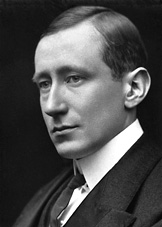Guglielmo Marconi Biography
Guglielmo Marconi sent the first transatlantic radio message in 1901 and won the Nobel Prize for physics in 1909.
Biography
Marconi was born at Bologna, Italy, on April 25, 1874. He was educated privately at Bologna, Florence and Leghorn. Even as a boy Marconi displayed a keen interest in physics and electronics. In 1895 he began laboratory experiments at his father’s country estate where he succeeded in sending wireless signals over a distance of one and a half miles.

Guglielmo Marconi
In 1896 Marconi took his apparatus to England. Later that year he won the world’s first patent for a system of wireless telegraphy. Marconi demonstrated his system successfully in London, on Salisbury Plain and across the Bristol Channel, and in July 1897 formed The Wireless Telegraph & Signal Company Limited.
Major inventions
In 1900 Marconi took out his famous patent No. 7777 for ‘tuned or syntonic telegraphy’ and, on an historic day in December 1901, he used his system for transmitting the first wireless signals across the Atlantic over a distance of 2100 miles and thus proved that wireless waves were not affected by the curvature of the earth.
Between 1902 and 1912 he patented several new inventions. In 1931 Marconi began research into the propagation characteristics of micro waves, resulting in the opening in 1932 of the world’s first microwave radiotelephone link between the Vatican City and the Pope’s summer residence at Castel Gandolfo. Two years later at Sestri Levante he demonstrated his microwave radio beacon for ship navigation and in 1935, again in Italy, gave a practical demonstration of the principles of radar.
Honours and awards
Marconi has been the recipient of honorary doctorates of several universities and many other international honours and awards, including the Nobel Prize for Physics. He has also won the Albert Medal of the Royal Society of Arts, the John Fritz Medal and the Kelvin Medal. Marconi died in Rome on July 20, 1937.